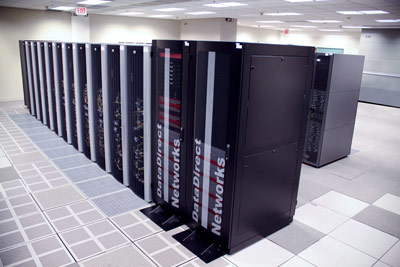ACADEMIA
OSC’s Oakley Cluster delivers on performance efficiency
New system ranks 9th in U.S., 2nd among U.S. academic institutions
The Ohio Supercomputer Center’s newest system would fall in the top half of the list of the world’s most powerful supercomputers based purely on speed, but the cluster would rank even higher – ninth in the United States and second among U.S. academic institutions – when comparing benchmarked performances against the maximum theoretical performance of the system.
{modal url=http://www.supercomputingonline.com/images/oakley_clusterlrg.jpg}
 {/modal}
{/modal}
 |
| Chancellor Jim Petro |
“Major investments, such as the one made to purchase the new HP/Intel supercomputer, must be made carefully,” noted Jim Petro, chancellor of the Ohio Board of Regents – the state agency that created the Ohio Technology Consortium to oversee the Ohio Supercomputer Center (OSC) and other statewide technology resources. “These benchmark statistics show me that we’ve not only given our researchers a powerful resource with this investment, but also have given Ohio taxpayers a great value.”
OSC engineers recently opened the Oakley Cluster to general users after they benchmarked the performance of their new system, based on 694 HP ProLiant SL390 G7 servers. The engineers compared their benchmark results with the latest list of the world’s fastest supercomputers, generated twice each year by the Top500 Project. The international TOP500 project was started in 1993 to provide a reliable basis for tracking and detecting performance trends in supercomputing. Based on the comparisons, OSC’s new system would rank as the 180th fastest supercomputer in the world, 89th in the United States and 11th among U.S. academic institutions.
More interestingly however, using additional data compiled by Top 500 Project, OSC engineers analyzed how well the supercomputers on the list performed in the benchmark tests, compared to the maximum theoretical performance of the machine.
In those comparisons, the Oakley Cluster ranked much higher – 22nd in the world, 9th in the United States and 2nd among U.S. academic institutions.
“What these performance efficiency findings tell us is that HP and OSC working together were able to optimize the performance of the machine to deliver more compute capability to our users.” said Kevin Wohlever, director of supercomputer operations at OSC. “We worked very closely with HP, Intel and other subcontractors for several months to design a highly efficient system that would meet the needs of our user-communities, and all our careful design work has paid off.”
OSC’s HP Intel Xeon processor based supercomputer, named after the famous Ohio sharpshooter Annie Oakley, can achieve 88 teraflops, which is tech-speak for performing 88 trillion calculations per second.
The new system features more cores (8,328) on half as many nodes (694) as the center’s former flagship system, an IBM Opteron 1350 Glenn Cluster. The Oakley Cluster provides nearly twice the memory per core (4 gigabytes) than Glenn and three times the number of graphic processing units or ‘GPUs’ (128). Oakley also provides researchers with one and a half times the performance of the Glenn Cluster at just 60 percent of Glenn’s power consumption.
In addition, while not used in these efficiency studies, the OSC system has the ability to support NVIDIA Tesla 2070 graphic processing units (GPUs), giving the system a total peak performance of 154 teraflops. And, the addition of 600 terabytes of new DataDirect Lustre storage expands OSC storage to nearly two petabytes.
OSC is a state-funded high performance computing center that provides Ohio’s universities, industries and other clients with computation, software, storage and support services. OSC’s centralized support increases the opportunities for researchers statewide to innovate and successfully compete for grants and national supercomputing resources. Major users of OSC’s resources have focused on research in the areas of the biosciences, advanced materials, energy and the environment.
